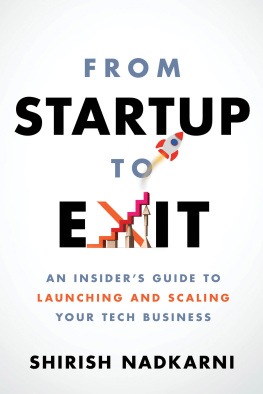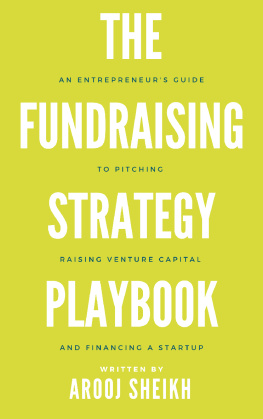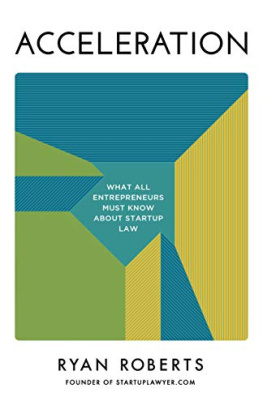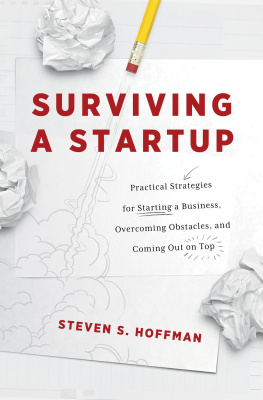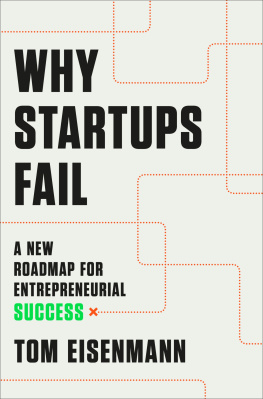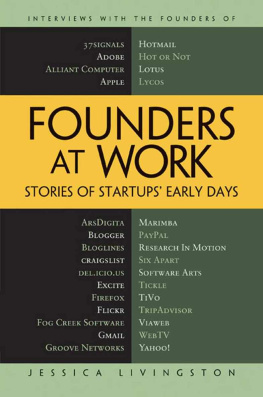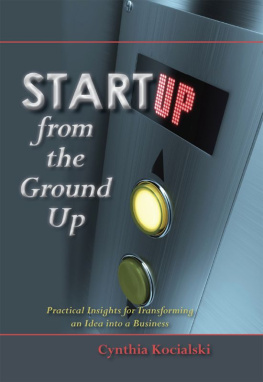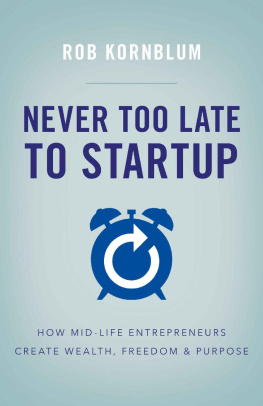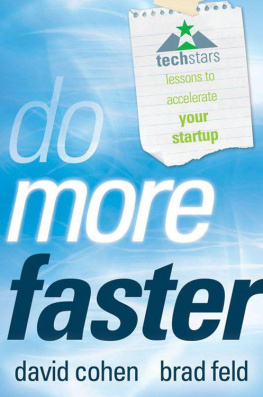THE FOUNDERS DILEMMAS
THE KAUFFMAN FOUNDATION SERIES ON INNOVATION AND ENTREPRENEURSHIP
Boulevard of Broken Dreams: Why Public Efforts to Boost Entrepreneurship and Venture Capital Have Failedand What to Do about It, by Josh Lerner
The Invention of Enterprise: Entrepreneurship from Ancient Mesopotamia to Modern Times, edited by David S. Landes, Joel Mokyr, and William J. Baumol
The Venturesome Economy: How Innovation Sustains Prosperity in a More Connected World, by Amar Bhid
The Microtheory of Innovative Entrepreneurship, by William J. Baumol
Solomons Knot: How Law Can End the Poverty of Nations, by Robert D. Cooter and Hans-Bernd Schfer
ANTICIPATING AND
AVOIDING THE PITFALLS
THAT CAN SINK
A STARTUP
NOAM WASSERMAN

Copyright 2012 by Princeton University Press
Published by Princeton University Press,
41 William Street, Princeton, New Jersey 08540
In the United Kingdom: Princeton University Press,
6 Oxford Street, Woodstock, Oxfordshire OX20 1TW
press.princeton.edu
All Rights Reserved
Seventh printing and first paperback printing, 2013
Paperback ISBN 978-0-691-15830-3
The Library of Congress has cataloged the cloth edition of this book as follows
Wasserman, Noam, 1969
The founders dilemmas : anticipating and avoiding the pitfalls that can sink a startup / Noam Wasserman.
p. cm. (The Kauffman foundation series on innovation and entrepreneurship)
Includes bibliographical references and index.
ISBN 978-0-691-14913-4 (hardcover)
1. New business enterprisesManagement. 2. Entrepreneurship.I. Title.
HD62.5.W375 2012
658.11dc23
2011037954
British Library Cataloging-in-Publication Data is available
Published in collaboration with the Ewing Marion Kauffman Foundation and the Berkley Center for Entrepreneurial Studies, New York University
This book has been composed in Sabon and Trade Gothic
Printed on acid-free paper.
Printed in the United States of America
10 9 8 7
CONTENTS
ILLUSTRATIONS
PART I
INTRODUCTION AND
PRE-FOUNDING
CHAPTER ONE
INTRODUCTION
ITS UNFORTUNATE BUT TRUE: IF ENTREPRENEURSHIP IS A BATTLE, most casualties stem from friendly fire or self-inflicted wounds. Some four decades ago, sociologist Arthur Stinchcombe attributed much of the liability of newnessthe particularly high failure rate of new organizationsto problems within a startups founding team. More recently, venture capitalists in one survey attributed 65% of failures within their portfolio companies to problems within the startups management team.
Researchers have extensively studied the failure rates highlighted by Stinchcombe. Unfortunately, they have focused almost entirely on external causes rather than on the more numerous internal problems Stinchcombe identified.
sometimes because natural inclinations such as passion, optimism, and conflict avoidance lead to shortsighted decisions. This book delves into the challenges faced or created by each of the main groups of players involved in a typical startup, beginning with the core founder and moving on to his or her cofounders, early hires, and investors.
Ive spent over a decade working with hundreds of founders and future founders, and Ive collected and analyzed data on nearly 10,000 founders in the technology and life sciences industries. This book will draw on my unique dataset, and we will also follow actual founders as they launch new companies and struggle with dilemmas identified in my research. Most centrally, we explore the experience of Evan Williams, a young entrepreneur who moved from rural Nebraska to the San Francisco area in the mid-1990s, hoping to catch the wave of the Internet boom after working on a failed startup back home. A self-taught Web designer and programmer, Evan recognized the potential of Internet applications, particularly in the exploding area of self-publishing, and created Blogger, one of the first and most popular blogging tools. Later, Evan developed an early podcasting idea, Odeo, which he believed would enable nontechnical people to produce, publish, and share audio content, much as Blogger had done for millions of ordinary people with the written word.
In both startups, and then later when he went on to found and lead Twitter before leaving to work on yet another startup, Evan faced key dilemmasdifficult decisions at important forks in the road of his entrepreneurial journeyand took steps that would shape the startups future, affect its value, and help determine his degree of control over it. With Blogger, Evan chose to cofound with his former girlfriend, fighting to retain for himself the CEO title and a majority of the equity. He funded the company using his own money along with money from friends, family, and angel investors, intentionally avoiding venture capitalists (VCs). He hired friends (and later, volunteers) to inexpensively develop the technology. When the dot-com boom ended and Blogger ran low on cash, he received an acquisition offer but refused to sella decision that would send his cofounder and his entire staff fleeing for the exits and reduce him to soliciting donations to keep Blogger alive.
Evan eventually sold Blogger to Google and turned next to developing Odeo, partnering with an acquaintance who had experience in online audio. Using some of his proceeds from Blogger, Evan seeded Odeo and let his cofounder take the CEO role. As Evan realized the huge potential for podcasting, he took over as CEO and raised $5 million from VCs, who stepped in to help make significant decisions. With the VC money, Evan hired an experienced and expensive leadership team, hoping to develop Odeo quickly enough to stay ahead of foreseeable and formidable competitors such as Apple and Yahoo.
Evan holds particular interest for us because his very different approaches to founding and running Blogger and Odeo highlight the wide variety of options available to founders. Evans decisions may seem wildly inconsistent: He takes VC funding in one case and vehemently resists it in another. He hires his pals for next to nothing in one case and pays big bucks for the pros in another. He battles his own ex-girlfriend for the CEO role and finally squeezes her out of the company but then readily turns the reins over to a mere acquaintance in his second startup. Going deep into Evans story, we will explore both the underlying consistency of his decisions and the powerful motivations and situational factors at work, an exercise that will enable current or would-be founders and others involved in startups to unlock the mystery of their own motivations and dilemmas as they enter the battle that is entrepreneurship.
CORE CONCEPTS AND ARGUMENTS
Founding a startup can seem like a fragmented, even chaotic, way of life. Perhaps no business pursuit is messier than creating an organization from scratch. Founders themselves are an extremely varied group, and academic research on entrepreneurs is fragmented, with different researchers looking at different stages of the founding process, turning different disciplinary or functional lenses on the issues they study, and developing findings with little apparent consistency. Meant for entrepreneurial scholars, educators, and mentors of entrepreneurs as well as entrepreneurs themselves,


